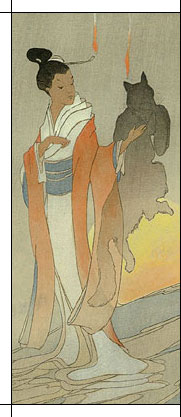|

Graveyards, roofs, and your own living room
Fox abodes
Unlike fairies, foxes have no separate realm; they dwell in the
material world, just like their less-talented animal brothers and
sisters. Their idea of good real estate varies considerably, though.
In tales, foxes live:
- In dens in the woods, like ordinary foxes.
- In tombs, or in dens dug into graves. Foxes bear a close relationship
to the dead. Sometimes this relationship is almost brotherly,
and foxes live in the graveyard out of fellow feeling for the
dead. Occasionally, however, a fox digs burrows through a graveyard
to eat the corpses. (This theme is more common in Korea.) In some
traditions, foxes need human skulls to transform into human shape,
so they may live in the graveyard to be close to the raw material
for their magic. In most stories, though, the reason the fox lives
in the graveyard is unstated. Foxes are close to the dead, and
that's reason enough.
- In an abandoned house. Foxes often take up residence in abandoned
or ruined houses, which might show themselves in their full, uncrumbled
magnificence to humans who happen upon them. Sometimes the house
has the reputation of being haunted; sometimes it has no reputation,
and the bewildered visitors discover later that their gracious
hosts were something more or less than human. The magic used to
disguise these houses is the same used by more conventionally
denned foxes to make their holes in the ground look like houses
or palaces.
- On the grounds of human houses. Foxes occasionally den in the
garden or under the house, and make a racket running to and fro
all night. In a Japanese story, a householder was so irritated
by the noise that he called a fox hunter to come and kill the
foxes. The night before the hunter was due, the patriarch of the
fox clan appeared to the man in a dream and begged the man to
give his family another chance. He promised that he would keep
the foolish youngsters of the family under control. The man agreed,
with the proviso that he would call the hunter back if the ruckus
started up again, and from then on peace reigned. (Note that the
head of the family was able to take on human form, but the younger
members presumably could not.)
- In the rafters of human houses. Chinese foxes often live invisibly
in the exposed rafters, the better to raise hell for their unwilling
hosts. They fill the same niche in China's spiritual ecology as
the poltergeist, and do all the same things. The rafters are also
the home of choice for a variety of good and neutral foxes, but
in general, if a Chinese roof is infested, it's no good for anyone.
The previous three fox homes make sense from a naturalist's point
of view. Foxes live anywhere they can find food, and that includes
graveyards and back yards. However, they're firmly land-dwelling
creatures. They might climb a tree from time to time, but they
prefer to live where they can dodge into a hole easily. So why
does story after story put them in the rafters? Is this just a
folklore convention, or were old Chinese houses built such that
foxes really did live in their rafters?
- In a room of a human house. Like ghosts, foxes sometimes haunt
a room of a house. Sometimes they let the family use the room
during the day, but insist upon having food and wine laid out
for them so they can have a private feast at night. Sometimes
they throw things around and break everything they can lay their
paws on unless they're given the room for the entire day. Sometimes
they make a mess even when they do get the room to themselves
for the entire day. Sometimes they make a mess and demand
food and drink. And sometimes they're sweet as sugar and quiet
as a mouse, the better to lure an unsuspecting visitor into the
room for a leisurely kill. They are almost always invisible, usually
but not always solitary (there are memorable stories of entire
fox drinking parties), and always in need of a good, strong exorcism.
or, barring that, a team of fox hunters.
Foxes also live in human houses, palaces, brothels, and monasteries
as "human" inmates of those places.
The interiors of fox houses are a mystery. Stories rarely describe
the inside of foxes' houses, and what few interiors we do see tend
to be enchanted to look just like real Chinese or Japanese houses
of the period. What few vague hints the stories give about the inside
of fox houses suggests that the storytellers thought of foxes as
living in primitive adaptations of human houses.
|

